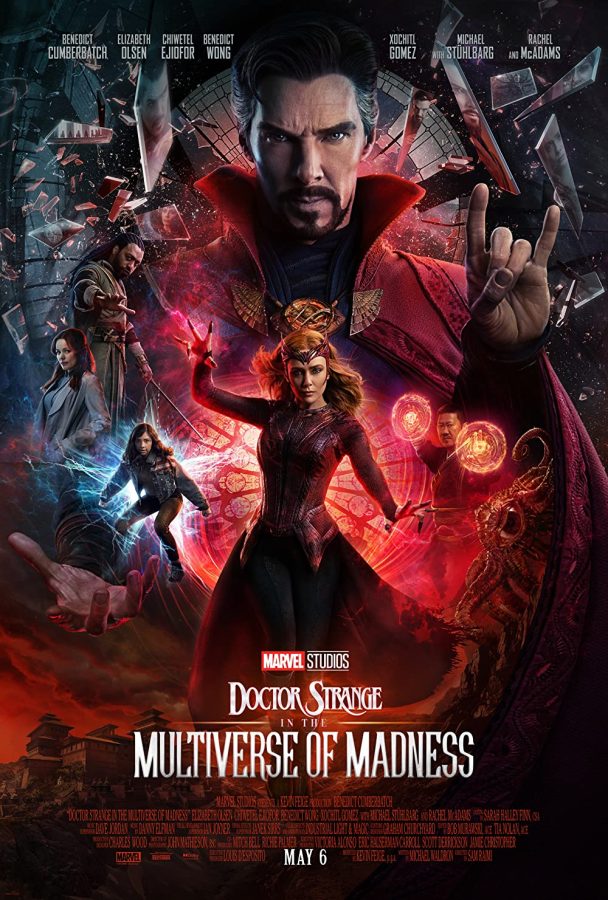“Doctor Strange in the Multiverse of Madness”: a Marvel fan’s guide to unhealthy coping
Marvel Studios satisfies fans and expands its horizons with “Doctor Strange in the Multiverse of Madness.”
Rule one of multiversal travel: You don’t know anything.
The rule certainly rings true after a series of electrifying multiversal jumps that leaves the superheroes dazed, confused and in Stephen Strange’s case, puking his guts out. Combining Marvel’s signature witty dialogue, multi-faceted characters and well-paced action with a slightly horror-based mood, this new film marks the beginning of a new era of Marvel movies — one that may not be to everyone’s taste.
Doctor Stephen Strange (Benedict Cumberbatch) takes center stage alongside Wanda Maximoff (Elizabeth Olsen) to deliver a jaw-dropping performance worthy of its predecessor. Cumberbatch skillfully portrays Strange’s messy journey to heroism, obsessive tendencies and all, and is matched only by Olsen. She stunningly embodies Maximoff’s raw and palpable grief from the loss of her children while exploring her somewhat unexplained and limitless powers. The only complaint would be the laughable lack of chemistry between Cumberbatch and his romantic interest Dr. Christine Palmer — Cumberbatch may find better luck flirting with his cloak.
Though some of the secondary characters inevitably pale in comparison to such dynamic leads, the film is buoyed by its expert cast, breaking from Marvel’s formulaic character arcs and plot devices to varying degrees of success. The first hour and a half or so are classic Marvel action — all dynamic movements and cinematic angles, explosive battles and psychedelic special effects. The conclusion’s controversial resolution is made better for its irregularity, eschewing Marvel’s signature action in favor of thoughtful character development and insight into the minds of the characters. Marvel’s willingness to show superheroes at their most vulnerable has always been one of its main selling points, and this film is no exception. Its careful examination of grief feels like a breakthrough as the studio refuses to shy away from the most broken parts of humanity.
Regardless of whether or not one appreciates the character-driven conclusion, the addition of horror elements proves to be exhilarating. Director Sam Raimi, best known for his prolific horror movie background and the original Spiderman trilogy, brings his arsenal of cinematography tricks to the Marvel Universe. His years of experience shine throughout the film as he masterfully subverts horror movie tropes while still hanging onto a PG-13 rating. The film’s numerous references to horror classics will charm adult audiences, even if younger children may find the violence and jumpscares to be a bit much.
Despite Marvel’s exciting venture into horror, the studio will likely struggle to keep new fans. Diehard comic enthusiasts may enjoy the increasing complexity and interconnectivity of the Marvel Cinematic Universe, but this comes at the expense of more casual fans, who will likely struggle to stay caught up with all the new characters, superpowers and backstories. “Multiverse of Madness,” is an unabashed continuation of the Disney+ show “WandaVision,” and wastes very little screen time explaining anything that happened before. Marvel seems to be promoting its streaming services on Disney+ through traditional cinema by forcing fans to stay caught up with all its new releases or go through all two hours and six minutes of the film in utter confusion. The subliminal references and jokes may leave a casual audience upset and wondering what they missed.
At its heart, “Doctor Strange in the Multiverse of Madness” presents an insightful look into grief bolstered by familiar Marvel production and acting. While the movie may turn away younger or newer fans, it ultimately delivers the exhilarating experience expected of a characteristic Marvel movie. As madness of all sorts from zombies to bizarre paint flashes across the screen, it’s easy to let go of all criticism and just enjoy the thrill of the ride.





